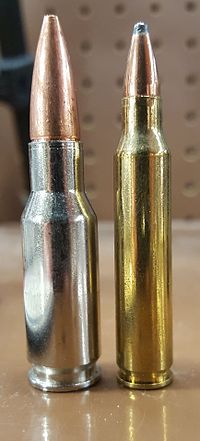| .30 RAR (.30 Remington AR) | ||||||||||||
|---|---|---|---|---|---|---|---|---|---|---|---|---|
 Size comparison with .223 | ||||||||||||
| Type | Rifle, Centerfire | |||||||||||
| Place of origin | United States | |||||||||||
| Production history | ||||||||||||
| Designed | 2008 | |||||||||||
| Manufacturer | Remington | |||||||||||
| Produced | 2008–present | |||||||||||
| Specifications | ||||||||||||
| Parent case | .284 Winchester | |||||||||||
| Case type | Rimless, bottleneck | |||||||||||
| Base diameter | .500 in (12.7 mm) | |||||||||||
| Rim diameter | .492 in (12.5 mm) | |||||||||||
| Rim thickness | .054 in (1.4 mm) | |||||||||||
| Case length | 1.53 in (39 mm) | |||||||||||
| Overall length | 2.26 in (57 mm) | |||||||||||
| Case capacity | 44 gr H2O (2.9 cm3) | |||||||||||
| Rifling twist | 1:10 | |||||||||||
| Primer type | Large rifle | |||||||||||
| Maximum pressure | 55,000 psi (380 MPa) | |||||||||||
| Ballistic performance | ||||||||||||
| ||||||||||||
| Test barrel length: 24 Source(s): http://accurateshooter.wordpress.com/2008/10/15/remington-introduces-new-30-remington-ar-cartridge/ | ||||||||||||
The .30 Remington AR / 7x39mm Remington AR is an intermediate cartridge created in 2008 by Remington Arms to fill a perceived gap in performance on large game between the .223 Remington and larger cartridges such as the .308 Winchester. [1] The design of the cartridge is considered a joint effort between companies under the "Freedom Group" name through a private equity firm [1] and included such companies as Bushmaster, DPMS and Remington itself. It is a rebated rim cartridge designed to fit Remington's R-15 semiautomatic hunting rifle. It was made to fit the dimensional constraints of the AR-15 magazine and is based on a modification of the .450 Bushmaster, which in turn is based on the .284 Winchester. [2]
Contents
Remington was the only company that manufactured this ammunition and its components. [3] The cartridge was a commercial failure and has been discontinued by Remington.[ citation needed ]

